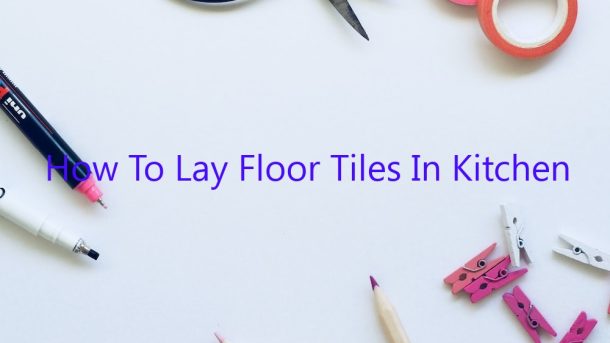There are many factors to consider when laying floor tiles in a kitchen. It is important to plan the layout of the tiles carefully, taking into account the size and shape of the room, the position of the doorways and windows, and the type and size of the tiles. The tiles should also be selected to match the style of the kitchen.
The first step is to mark out the area to be tiled. This can be done using a piece of chalk or a piece of tape. The tiles should be laid out in the correct order and the tiles at the edges of the room should be cut to size.
The adhesive should be spread evenly over the floor using a trowel and the tiles should then be laid in place. The tiles should be pressed firmly down into the adhesive and should be aligned with the edges of the room. Spacers can be used to ensure that the tiles are evenly spaced.
The tiles can then be grouted. The grout should be mixed to a thick consistency and should be applied to the tiles using a grout float. The excess grout should be removed and the tiles should be allowed to dry for 24 hours.
Contents
- 1 Where do you start when laying kitchen floor tiles?
- 2 What do you put under kitchen floor tiles?
- 3 Is it better to install tile flooring under kitchen cabinets or not?
- 4 What should you put down before tiling a floor?
- 5 Do you start in the middle when tiling?
- 6 How do I start tile layout?
- 7 Do I need cement board under floor tile?
Where do you start when laying kitchen floor tiles?
When you’re planning to lay kitchen floor tiles, one of the first decisions you’ll need to make is where to start. This may seem like a simple question, but it’s actually not as straightforward as you might think. Here are a few factors to consider when deciding where to start:
1. The layout of the room
One of the most important things to consider when laying kitchen floor tiles is the layout of the room. You’ll need to take into account the size and shape of the room, as well as any obstacles that might be in the way (like cabinets or appliances).
2. The direction of the room
Another thing to consider is the direction of the room. If the room is long and narrow, it might be better to start laying tiles at the end of the room rather than in the middle. This will help to avoid having too many joins in the floor.
3. The type of tiles you’re using
The type of tiles you’re using can also play a role in determining where to start. Some tiles, like porcelain tiles, are more difficult to cut than others, so it might be easier to start with those tiles at the end of the room.
4. The size of the tiles
Tiles also come in different sizes, so you’ll need to take that into account when deciding where to start. Smaller tiles are easier to handle and fit together, so they might be a good choice for the beginning of the project.
5. The amount of time you have
Finally, you’ll need to take into account the amount of time you have to complete the project. If you’re short on time, it might be better to start in the middle of the room so you can work more quickly.
No matter what factors you consider, there’s no wrong or right answer when it comes to deciding where to start laying kitchen floor tiles. It ultimately depends on your individual preferences and the layout of your room. Talk to a professional flooring installer for more advice on the best way to lay your tiles.
What do you put under kitchen floor tiles?
If you’re planning on installing kitchen floor tiles, you’ll need to put something down first to create a smooth, even surface. This can be a layer of mortar, cement, or a self-leveling compound.
Mortar is a mixture of cement, sand, and water. It’s often used to create a base for tiles, bricks, or stone. Cement is a type of mortar that’s made from limestone, clay, and silica. It’s stronger than mortar and can be used for outdoor projects.
Self-leveling compound is a type of liquid concrete that’s used to create a level surface. It comes in a variety of colors and can be used to cover uneven surfaces.
Once you’ve chosen your base, you’ll need to apply it to the floor. Be sure to follow the manufacturer’s instructions carefully. Once the base has dried, you can install your kitchen floor tiles.
Is it better to install tile flooring under kitchen cabinets or not?
In some kitchens, tile flooring is installed under the cabinets, while in others it is not. So, is it better to install tile flooring under kitchen cabinets or not?
There are pros and cons to both options. Installing tile flooring under kitchen cabinets can make the flooring more durable, as it will be protected from spills and dirt. However, it can be more difficult to clean under the cabinets if there is tile flooring installed.
If you do not install tile flooring under the cabinets, it will be easier to clean, but it is more susceptible to damage from spills and dirt.
Ultimately, the decision of whether or not to install tile flooring under kitchen cabinets is up to the individual homeowner. There are pros and cons to both options, so it is important to weigh the pros and cons and make a decision that is best for your home.
What should you put down before tiling a floor?
There are a few things you should put down before tiling a floor: a layer of mortar, a layer of cement, and a layer of sand.
The mortar layer is the most important. It should be at least 1.5 inches thick, and it should be made of a mix of one part cement and three parts sand. The mortar will provide a solid foundation for the tiles, and it will help to keep them in place.
The cement layer is also important. It should be about half an inch thick, and it should be made of a mix of one part cement and four parts sand. The cement will help to keep the tiles in place and will also help to protect the floor from water damage.
The sand layer is the least important. It should be about half an inch thick, and it can be made of any type of sand. The sand layer will help to level the floor and will make it easier to tile.
All of these layers should be applied in a thin, even layer. Be sure to wait for the mortar to dry before applying the next layer.
Do you start in the middle when tiling?
When it comes to tiling, there are a few different ways to approach the task. Some people start by tiling the entire surface, while others start in the middle and work their way out. So, which approach is the best?
In general, it’s usually better to start in the middle and work your way out. This approach is more efficient, and it also helps to avoid mistakes. If you start in the middle, you can easily adjust the tiles as needed, and you won’t have to worry about creating a straight edge at the beginning or end of the project.
Of course, there are some exceptions to this rule. If you’re tiling a curved surface, for example, it might be easier to start at one end and work your way around. Or, if you’re tiling a small surface, it might make more sense to start in one corner and work your way across.
In general, though, it’s a good idea to start in the middle and work your way out. This approach is simple, efficient, and less likely to cause mistakes.
How do I start tile layout?
When it comes to home improvement projects, laying tile can be one of the most rewarding endeavors. Not only is it a relatively simple task, but the end result can be incredibly stunning. If you’re new to the world of tile layout, however, the process may seem a little daunting. Thankfully, getting started is actually quite easy. Here’s a look at how to get started laying tile:
1. Decide on a Design
The first step in any tile layout project is to decide on a design. This may be something as simple as a basic grid pattern, or you may want to create a more complex design. If you’re not sure where to start, there are plenty of online resources available, or you can consult with a professional.
2. Measure the Area
Once you have a design in mind, you’ll need to measure the area you’ll be tiling. This will help you determine how much tile you need to purchase. Be sure to measure carefully, making sure to account for any cuts that will need to be made.
3. purchase the Tile
Once you have your measurements, it’s time to head to the hardware store and purchase your tile. Choose a tile that is appropriate for the area you’re tiling and the design you’ve chosen. Be sure to purchase enough tile to complete the project, plus a little extra for cuts and mistakes.
4. Prepare the Area
Once you have your tile, it’s time to start preparing the area you’ll be tiling. This includes removing any old tile or flooring, and cleaning the surface thoroughly. If you’re tiling a floor, you’ll also need to install a subfloor if one is not already in place.
5. Start Laying the Tile
Now it’s time to start laying the tile. Begin by laying out the tiles in the layout you’ve chosen, making sure to leave enough space for cuts. Once you have the layout set, start adhering the tiles to the surface using tile adhesive. Be sure to follow the directions on the adhesive carefully, and allow the adhesive to dry completely before moving on.
6. Finish the Tile Layout
Once the tiles are adhered to the surface, it’s time to finish the layout. This may include cutting tiles to fit around corners and edges, and installing tile trim to give the finished project a polished look.
Tile layout can be a challenging but rewarding project. By following these simple steps, you can be on your way to a beautifully tiled surface in no time.
Do I need cement board under floor tile?
The short answer is yes, you likely need cement board under floor tile. Cement board is a water-resistant material that helps to create a solid and stable foundation for tile. Floor tile is often quite heavy, and without a proper base, it can cause damage to your floors and even lead to tiles cracking or popping off the surface.
Cement board can be installed in several different ways, but the most common approach is to attach it to the subfloor with screws or adhesive. Once it’s in place, you can then install your floor tile over top. Keep in mind that if you’re using a mortar-based adhesive, you’ll need to wait for it to dry before laying your tile.
If you’re not sure whether you need cement board under your floor tile, it’s best to consult with a professional. They can assess your floor and recommend the best course of action.




